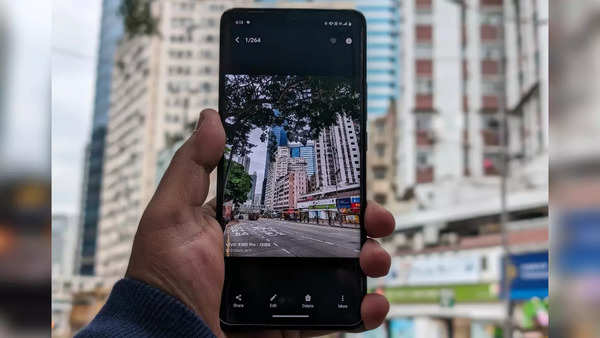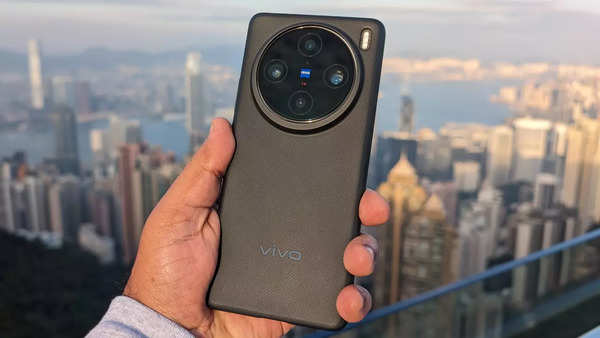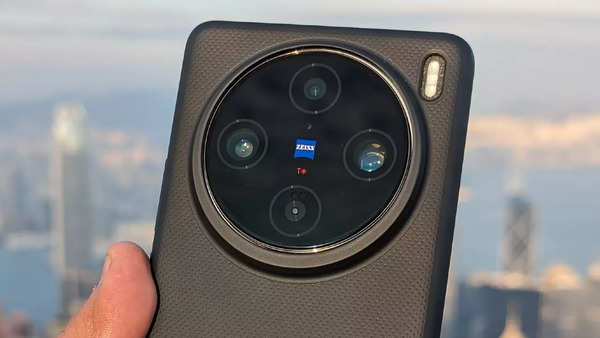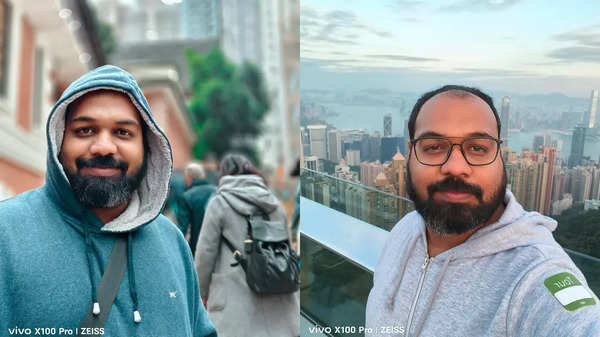Camera capability
is one of the most prominent features that helps smartphones stand out from the crowd. The fact that prominent smartphone makers such as Vivo are going to lengths to get a powerful phone in users’ hands that not only offers great performance but a camera worthy of giving tough competition to
DSLR cameras
attests to the fact that
smartphone photography
has not reached a saturation point. Every year, we have seen some innovation in this space with the Apples, Samsungs and Googles working to get that smartphone camera king crown.
Vivo started the year by launching its X series flagship smartphone lineup – the
Vivo X100 Pro
and Vivo X100. We got the
Vivo X100
Pro to check out and we spent a considerable time exploring the smartphone and testing its photography prowess. There is a lot to scrutinise when a smartphone has a lot to offer, especially when it aims to tread into the category of the popular phones that cost near a lakh. Let’s dive straight into what this phone has to offer.
Vivo X100 Pro price in India
The Vivo X100 Pro was launched in India in a 16GB+512GB variant for Rs 89,999 in Asteroid Black colour option.
Vivo X100 Pro design and display
In our review of Vivo X90 Pro, we wrote that the phone has room for improvement and the Vivo X100 Pro did streamline some things. The phone largely has a similar design as last year’s offering, however, the subtle tweaks make much difference in enhancing the overall look. It has a tall stance that definitely helps in better grip even for those who have smaller hands.
From the front, it is closer to what it looked like last year. There is a curved display that shines bright under all conditions. The curved 6.78-inch FHD AMOLED display gets a 2800x1260 pixels resolution, 120Hz Adaptive refresh rate and up to 3000 nits peak brightness with 452 ppi pixel density. Other technologies include 8T LTPO Eye Protection with the 8T Technology that allows finer control over frame rates with low power consumption. Vivo claims that its Night Eye Protection Mode is the industry's first with its optimisation for extra-dim light conditions.

In real-world usage, there is a lot less to talk about as no one will probably pay heed to what’s behind that display which actually makes the difference. Long things short: Details and sharpness levels of the display are top-notch with little room for improvement at this period of innovation; the viewing angles are fine and Vivo has improved on outdoor visibility. We did not find any shortcomings as far as the performance of the display is concerned, however, with OEMs increasingly moving to flat panel screens, Vivo sticking with the curved edges is a bit dated.
On the back, there is a lot that has changed. While Vivo went with the same, protruded circular camera island, there are changes in terms of the size, design and texture of the back panel. Instead of a left-aligned camera island on the Vivo X90 Pro, Vivo chose to install a large, centrally-aligned camera island on the Vivo X100 Pro. Not only does it balance the phone’s look, it does not wobble – a complaint that we had with the Vivo X90 Pro.
The camera ring is now bigger, protruding almost half the thickness of the phone when kept flat and it turns heads. The protrusion ‘problem’ can be fixed by the back cover provided in the box but it must be noted that stashing so much imaging technology in a smartphone that is marketed as a camera-first offering, does make phones thicker. We saw a similar design in the Oppo Find X6 Pro last year.

The Vivo X100 Pro has a Sun Halo design while the non-pro version gets a Moon halo design. The island also gets inspiration from luxury watches. But what we didn’t like is all that ‘beauty’ was hidden by the cover that came in the box. So if you want to flaunt the design, you’ll have to either use the phone with a transparent cover or use it without any protection.
We recommend using the phone with a solid cover due to two things: The first is the slippery back. Vivo moved from a leather finish back to a smooth, glittery design that makes the phone a freshly caught fish in wet palms. Secondly, the huge camera bump makes the phone’s weight distribution a bit unequal in favour of the upper half.
Vivo X100 Pro performance
Unlike the other flagships that go with Qualcomm’s Snapdragon SoC, Vivo has stuck with MediaTek’s top-of-the-line offering – Dimensity 9300 combined with the company’s next-generation V3 chip that is said to be “optimised for maximum performance.” Vivo also said that the chip also helps in delivering enhanced image quality and boosts that frame rate for a smoother experience.
It’s a 4nm chip with all big cores: four Cortex-X4 performance cores (up to 3.25GHz) and an equal number of Cortex-A720 efficiency cores (up to 2.0GHz). These numbers mean that all the tasks – gaming, day-to-day tasks and photography – are handled with a breeze.
We threw flagship games, including CoD Mobile, Asphalt 9 Legends and Genshin Impact and the phone managed to run all these games at maximum graphics. We did not face any considerable lags or delays to specifically point out. The phone was able to handle heat pretty well at both times: when gaming and when using the camera.
As far as day-to-day performance is concerned, the Vivo X100 Pro can handle every task with ease. We used the phone for browsing, calling, meetings, taking notes, playing games, watching videos and photography and videography. Vivo X100 Pro also boots up quickly, letting us use it in less than 10 seconds after its wallpaper appeared. The smartphone is IP68 dust and water-resistant.
Vivo X100 Pro got an update and runs FunTouch OS 14 based on Android 14 operating system. The animations and navigation are smooth and stutter-free. The software is more polished than last year’s FunTouch 13 and the user interface is a bit more ‘friendly’. The phone comes with preloaded apps, services and games, including Vivo’s app store. You can uninstall the pre-installed third-party apps but can only remove/ hide Vivo apps from the home screen.
Vivo X100 Pro camera
The Vivo X100 Pro gets one of the most featureful camera setups that we have seen. Apart from the regular modes, the camera comes with several industry-firsts. Before getting into the camera prowess, here’s a quick look at the hardware:
There is a 1-inch type 50MP Sony IMX989 main sensor with PDAF, laser-assisted autofocus and optical image stabilisation (OIS) married to a f/1.75 aperture lens. It is complemented by a 50MP ultra wide-angle sensor paired with f/2.0 aperture lens and a third 50MP sensor with a telephoto lens with (OIS) 4.3x Optical Zoom and f/2.5 aperture. On the front is a 32MP sensor with f/2.0 aperture lens.

There are several shooting modes: Snapshot, Night, Portrait, High Resolution, Pano, Ultra HD Document, Slo-mo, Long Exposure, Time-Lapse, Supermoon, Astro, Landscape & Architecture, Pro, Food, Live Photo and Cinematic Portrait.
The industry firsts
Vivo has claimed that there are some industry-first features, which include:
-- Apochromatic lens
-- "Floating Elements" lens
-- T* Coating (which was also in X90 Pro but X100 Pro has a multi-ALD coating that is claimed to offer 50% less reflectance, or lens flare
-- 1-inch sensor (newly-tuned, optical precision calibration for an equal amount of clarity in edges and centre)
-- Sunset and sunrise shots via telephoto
-- Zeiss multifocal portrait
-- Zeiss B-Speed Style Bokeh
Ditching the DSLR (maybe)
Vivo is taking its partnership with Zeiss forward and has brought refinement when it comes to smartphone photography. Firstly, the camera app has a multitude of options, with the ones that are frequently used can be accessed in up to three taps. Furthermore, there are also fine things like mention of focal length when choosing different zoom modes.
Under the Photo mode, if we tap the 0.5x, the UI will show the focal length as 15mm and the units change as we select other zoom modes 1x (23mm), 2x (46mm), 4.3x (100mm) and 10x (233mm) – making it a good choice for those who know using digital cameras.





While it is good to have all the options available quickly, it does add a bit of bulkiness in the user interface. Too many options available at all times may also make people a bit confused.
Among the available options, the colour treatment caught our attention. It features three modes: Vivid, Textured, and Zeiss Natural. Vivid mode enhances colours, producing a striking contrast for scene objects. However, in some instances, the colours appeared slightly unnatural, deviating from what was observed by the naked eye.


Steps in Zeiss Natural mode returned colours that are pretty much close to what we saw. The difference between the two modes is simple: You want your photo to have that Blue sky that makes it attractive, go for the Vivid mode. This saves time if you like to edit your photos before posting them on social media.
If you prefer more natural photos, and the sky looks grey just like we see it with the naked eye, go for Zeiss mode. We preferred the Natural mode but did play a lot with the Vivid mode. The third is the Texture mode which brought some more texture in the picture.
For example, clicking images of buildings with texture mode brought in more details in terms of lights, windows, doors, leaves and sky – without losing any dynamic range.
The primary camera captures detailed photos no matter the lighting condition. The photos have textures and great dynamic range. It comes with the Zeiss APO certification that reduces chromatic aberration, which means the output has accurate colours even at the edges.
Night-Owl approved
Images clicked in the night are also great for capturing near-accurate colours. The Zeiss T* coating reduces lens flare and images that have bright lights are handled well. Under conditions where the lights are too dim, the noise levels are acceptable and much of the details are intact. In these conditions, the photos are captured quickly and the processing time is nominal.


Shooting for the sun
Vivo was bullish on the telephoto camera during the deep dive session. While Samsung and Oppo went for the moon, Vivo went for the sun with Telephoto Sunshot. The floating mechanism also helps in clicking close-ups of objects with the zoom lens, without losing the quality. While the suitable zoom is 4.3X to click images, we got acceptable images with 10X zoom.


Portrait Mode that shines
Not only the shots of the sun but also shooting portrait photos. When shooting portraits using the Portrait camera mode, Vivo offers four professional modes that emulate Prime lenses:
24mm: Landscape Portrait
35mm: Street Portrait
50mm: Classic Portrait
85mm: Figure Portrait
100mm: Close-up Portrait
The Portraits captured at these focal lengths came out well but we’d like to mention that the images were not at the level of the ones captured with DSLR. It is a great feature to have on a smartphone but we think it will not surpass the quality of a Portrait photo captured from a professional camera.


The photos had enough details, for example, the threads of clothes and skin tones as well as marks. However, there was one instance when we found the Portrait mode a bit off. While using the different focal lengths on the same subject, the colours produced in the final photos were completely different.
We’d also like to highlight the Snapshot Mode that captured better images of subjects that are moving. For example, we captured photos of a fountain under low-light conditions and were able to click pictures of water drops.


The phone also comes with Handheld Astro Mode that harnesses the power of AR to showcase previews of constellations' shapes and connections.
Vivo X100 Pro battery
The battery life of the Vivo X100 Pro is pretty decent. It packs a 5400mAh battery that manages to deliver more than a day’s run time on some occasions. With moderate to heavy usage, we were able to easily squeeze out a day’s battery without having to reach for a charger till late at night. The phone supports 100W FlashCharge which is claimed to juice up 50% of the phone in 14 minutes and is fully charged in about 35-40 minutes. Apart from that, the phone comes with 50W wireless charging. Vivo is also claiming 4-year battery durability.
Verdict
The Vivo X100 Pro is a compelling option for those seeking a smartphone with a top-tier camera, however, the price tag might deter some. Vivo seems to have worked on the feedback and brought in refinements in terms of design, software and camera capabilities.
It offers excellent image quality, especially in low-light conditions and with zoom capabilities; there is a vibrant AMOLED display with a 120Hz refresh rate for a premium viewing experience; and the Dimensity 9300 chipset provides great performance for everyday tasks and even demanding games. But when you are spending close to Rs 1 lakh, consider priorities before making a decision.












 English (US) ·
English (US) ·